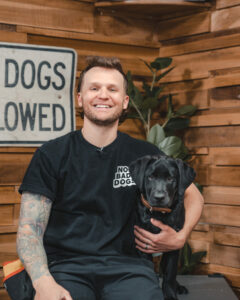Puppies are obviously cute, but their sharp little fangs can occasionally lead to unpleasant biting behavior in this blog we will tackle about the puppy bite training. Teaching your puppy not to bite is an important aspect of their training process and is critical for their socialization and interactions with people and other animals.
This post will look at five tried-and-true strategies for efficiently training your puppy to stop biting. We will present practical advice and insights to ensure a safe and pleasurable relationship with your furry buddy.
Understanding Why Puppies Bite
Why Do Puppies bite?
Puppy mouths explore the world in the same way as human babies use their hands and put things into their mouths. Your puppy just came from a litter. Their mom communicated with them through mouthing and biting. It is natural for puppies to want to bite due to teething and their playful behavior. It is important to understand that puppy biting is a natural instinct that will improve as the puppy matures. Teaching the puppy what to bite and what is unacceptable is part of the puppy training process! This skill becomes much more vital as puppies get larger and stronger.
Methods for Teaching Your Puppy Not to Bite
1. Establishing a Consistent Routine for Training
The key to successful puppy training is consistency, and teaching bite inhibition is no exception. Because dogs thrive on routine, adopting a consistent training program will assist your puppy in understanding what is expected of them. Consistency sends clear signals and reinforces the desired behavior across all family members, making the learning process easier for your beloved buddy.
Set a schedule for training sessions to successfully instruct your puppy on biting inhibition. Instead of extended, random sessions, aim for short, frequent ones. This not only keeps your puppy occupied, but it also keeps them from being overwhelmed or bored. To maintain consistency, choose a peaceful and distraction-free space for training and ensure that everyone in the family is on board with the timetable.
2. Positive Reinforcement Techniques for Discouraging Biting
When it comes to educating your dog not to bite, teaching a “no bite” or similar verbal command will be helpful. When your dog listens to the verbal command, reward your puppy with goodies, praise, and affection if he or she uses gentle mouthing or avoids biting entirely. This positive reinforcement helps them associate not biting with pleasant outcomes, increasing their likelihood of repeating the desired action.
3. Utilizing Redirecting Strategies to Prevent Biting
Despite your best attempts, your puppy may still try to bite you. Redirection is a useful technique in these instances. When your puppy attempts to nip or bite, shift their focus to a more suitable behavior, such as playing with a toy or chewing on a specific chewable. This not only prevents biting but also focuses their energy toward a more socially acceptable conduct.
Puppies tend to go after our hands because they are chasing movement. If your puppy is constantly biting at your fingers, make your hand into a fist. It will be a lot less fun to play with and it is likely the puppy will become disinterested.
Make sure your puppy has access to a range of toys and chewables to encourage redirection. By providing them with an alternative chewing outlet, you are effectively signaling what is suitable to bite and what is not. Keep these toys nearby so that if your puppy begins to bite, you can immediately shift their focus to the proper items.
4. Teaching Your Puppy Appropriate Chew Toy Behavior
Teaching your dog not to bite does not imply suppressing their natural want to chew. It is instead a matter of guiding their chewing habit toward appropriate chew toys. Here are two critical factors to consider: introducing and encouraging chew toy use, and selecting the appropriate chew toys for your pet.
Introducing and Encouraging Chew Toy Use
When first introducing chew toys to your puppy, make them intriguing and appealing. Demonstrate how much fun the toy is for your pooch by playing with it or chewing on it. When your dog shows interest in the chew toy, praise and encourage them to create positive associations.
It is critical to select the appropriate chew toys for your puppy. Look for puppy-specific toys made of softer materials that are easy on their developing teeth and gums. To avoid confusion, avoid toys that resemble household things. Choose toys that are long-lasting and can endure your little furry tornado’s chewing power.
5. Consistency and Patience: Keys to Successful Training
Teaching your puppy not to bite necessitates your constancy and patience. It is critical to remain engaged to the training process and recognize that progress takes time. Here are two important things to remember: being patient with your puppy’s progress and dealing with frustration and disappointments.
“Keep in mind that puppies are still learning and exploring their surroundings. They will not be able to master biting inhibition overnight. Keep your training efforts patient and constant, encouraging positive behavior and redirecting any biting tendencies. It may take some time, but your pet will eventually catch on.”
When your puppy’s biting behavior persists despite your attempts, it’s natural to feel frustrated or discouraged. Take a deep breath and tell yourself that setbacks are unavoidable. Maintain consistency in your training methods and make adjustments as needed. Seek help from other puppy parents or professional trainers to keep motivated and come up with new techniques.
6. Addressing Biting in Different Situations and Environments
Biting can occur in a variety of contexts and environments, including playing and social settings. To teach your puppy appropriate behavior, you must approach these circumstances differently. Consider the following approaches: dealing with biting during fun and dealing with biting in social situations.
Handling Biting During Playtime
Puppies may become excessively excited during playtime and nip or bite. Keep in mind, this is how dogs communicate! Establish clear limits by pausing play anytime biting occurs to address this.
Managing Biting in Social Settings
It’s critical to manage your puppy’s biting behavior when they interact with other dogs or people. Keep an eye on your puppy’s body language. Dog interaction can look a bit scary to humans, as they will typically growl, bark, and bite each other. It is important to understand the natural communication process between canines.
7. Seeking Professional Help if Biting Behavior Persists
Despite your best efforts, your puppy’s biting behavior may persist or worsen in some circumstances. If you’re feeling overwhelmed or unclear on how to proceed, don’t be afraid to seek expert help. Here are two points to consider when determining the need for professional assistance, as well as the advantages of working with a professional dog trainer.

If your puppy’s biting behavior becomes violent, frequent, or fails to improve despite persistent training, it’s time to seek professional assistance. A skilled dog trainer can assess the situation and provide specialized advice to solve the unique issues you and your puppy are experiencing.
Final Thoughts
Educating your puppy not to bite necessitates patience, consistency, and the use of tried-and-true training methods. You may help your puppy become a well-behaved and loving friend by recognizing the importance of bite inhibition, setting a schedule, utilizing positive rewards, correcting biting behavior, and teaching appropriate chew toy behavior.
Remember that training takes time, so be patient with your dog and applaud their accomplishments. If you notice repeated biting behavior, don’t be afraid to seek professional assistance.
You may help your puppy acquire good manners and a kind mouth with effort and an organized strategy.
Contact us for more information about dog training for your puppy! Visit our site
And more dog essentials at No Bad Dog
